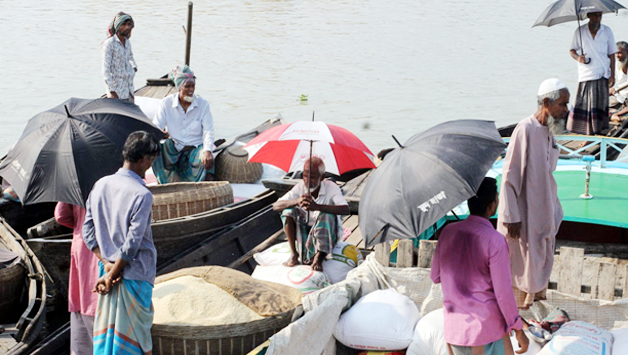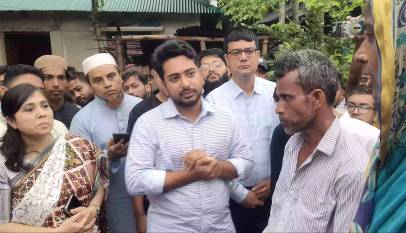Banaripara floating rice market running for 250 years
Barishal Correspondent: As soon as the rain stopped, the clouds came closer again at Sandhya river bank in new form. There is no sun in the monsoon sky. Gentle waves are breaking on the shore. In the meantime, boats are crowding the pontoon one by one. One is engine driven, the other is sitting. Someone came with glutinous rice; Someone is returning with a full throat.
By 8 o’clock in the morning, the chest of the river has become hot. The entire area is alive with the hustle and bustle of buyers and sellers, the busyness of seeing and understanding the products and bargaining. All the buyers and sellers come here in droves. That is why it is called floating rice market. Right across from the rice market is the paddy market.
Rice market from dawn to 11 pm, after which the paddy market accumulates. Runs till 2-3 pm.
Locals say, Bhasanmahal. Traders also call it as ‘cash market’ as all transactions at the buyer-seller level are done instantly in this market. Exactly in which year this hut was first established, no one knows the exact information. Businessmen have sustained the business from generation to generation
Such is the image of the famous rice and paddy floating market in Banaripara of Barisal. Locals say, Bhasanmahal. Traders also call it as ‘cash market’ as all transactions at the buyer-seller level are done instantly in this market. Exactly in which year this hut was first established, no one knows the exact information. Businessmen have sustained the business from generation to generation. According to them, for at least more than 250 years, haat has been accumulating here, where about 1500 maunds of paddy and rice are sold every day. Tourists from the country and outside the country flock to Banaripara to see the image of the market.
Upazila Banaripara is 18 kilometers west of the district headquarters. Every Saturday and Tuesday, a floating market gathers on the banks of the river Sandhya, which flows through the heart of this upazila headquarters. These two days are mainly market, but if the number of buyers and sellers increases, it is extended on Sunday and Wednesday. Locals call the extended period ‘Gala’.
From the etymological point of view, there is a close relationship between the naming of the upazila and trade. Banari is the colloquial form of Beniya, the most significant of the legends found in the naming of Banaripara. Centuries ago, Beniyas used to live in settlements in this town along the river. The entire upazila was named Banaripara after connecting the neighborhood with Banari, the spoken language of the Beniyas.
Banaripara upazila with an area of slightly more than 134 km is surrounded by Sandhya, Harta, Nalashri, Jainkathi and Swarupkathi rivers. Innumerable branches of rivers have entwined the township like canals and tree roots. Thanks to these rivers and canals, floating markets are still alive today.
Enayet Hossain, a local buyer in his 60s, said that paddy was bought from different regions of the south and sold in this market. Kutials bought it from here and prepared rice in their own way and sold it in this market. Thousands of boats used to come then, but not so much now. However, it is still important. There is a village called Malanga in Banaripara. Where the famous balam rice was prepared.

“When I was young, I saw that rice was taken from here in big cargo-launches and taken to different regions including Dhaka.”
Karbari Mizanur Rahman said, My grandparents used to trade rice and rice. I have been in this business for 18 years in the family. In Banaripara, the business mainly depends on the Kutials. However, the number of Kutials has decreased due to the introduction of auto-rice mills in various places. However, the commercial center of the region is still the floating market of Banaripara. Business is getting better this year compared to last year.
Abdul Hai, a former member of UP and a wholesale trader, said, “Vasman Hat is a good word but we know it as Bhasan Mahal.” Since the Pakistan era, traders used to bring rice from Barguna, Bhola, Khepupara, Charduani, Gnanpara, Pirojpur, Khulna, Satkhira here. When paddy was sold, rice was bought and taken to different areas. Bhasanmahal is our main source of income. Still one and a half thousand manas are sold in each haat.
Abdur Rahman, a businessman who brought paddy from Gopalganj, said, not only Gopalganj, but we buy paddy from different regions and sell here. We usually buy the field immediately after sowing. Been doing business here for over 20 years.
“Transportation of goods by river is cost-effective and can carry more than the prescribed quantity of goods to the destination. Suppose, a car can take 20 maunds of paddy. But trawlers have no limitations. I bought 125 maunds of paddy today. Cost and effort is less than the road,” said Kutial Md. Kauchar Make rice from the purchased rice and sell it again in the rice market after a week. He said, “As the Barisal region is surrounded by rivers, the river is still our main source of income.”
Hanif Bepari buys rice from this market and retails it from village to village. He said, “All types of paddy and rice are available in Bhasanmahal. Homemade rice is also available here. He buys as much as he needs. The rice that is available here is made completely by hand, so the taste and nutritional quality of the rice is good.
Even though it is more than 200 years old, there is no fuss in this market. There is no tax collection system. Even the rest of the products are not sold. Due to which no violence was created by middlemen. Vendors bring their goods in boats and anchor at the border of the market. Buyers come and check as they like and buy the necessary paddy and rice in cash. The goods are delivered to the buyer’s boat after measuring while sitting on the boat. That’s why many people call this market as cash market.
A few shops have also been built on the banks centered around the paddy-rice market. Where bread, bananas, cans, water, bean, tea are available. Many people come by boat to sell vegetables.
Vegetable seller Shamsul Haque said that vegetables are also sold well in this market. Since early morning there are many people who buy the vegetables they need. We buy the vegetables we need from the market according to the season and sell them here. I also sell vegetables from my own farm. My family depends on Bhasanmahal.
Researcher Anisur Rahman Khan Swapan said that Banaripara’s paddy-rice floating market is a part of the southern region’s tradition. It is the center of trade and investment in the region, especially in the riverine areas. Although the market is not as crowded as it used to be due to various reasons, it is still important.
“The Banaripara market can be an example of our river-economy and the development of river-based businesses. Because farmers, consumers, wholesalers and cottagers are associated with this market. The local administration should come forward to expand this traditional business center.
Banaripara Upazila Nirbahi Officer Antara Halder said that the floating market of paddy and rice has not only enriched the local economy, its fame has spread throughout the country and beyond. As the hut is located on the river, the rent is waived. As a result, all buyers and sellers are very interested in doing business in this market. I think, as long as rivers exist, river-centric markets and market-centric economies will survive.
Rare Israeli airstrike in Beirut kills Hezbollah commander and more than a dozen others
International Desk: Israel launched a rare airstrike that killed a senior Hezbollah milita…








